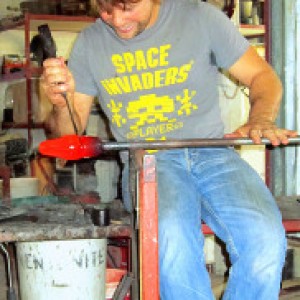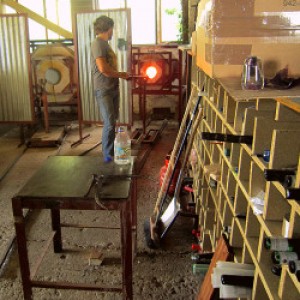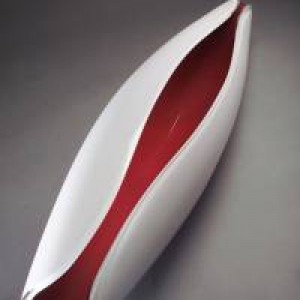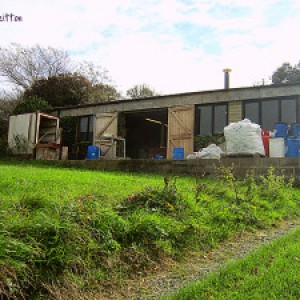Living and Breathing Glass
 With his work appearing in the V&A, Buckingham Palace and countless exhibitions around Europe and America, glass blower Carl Nordbruch has spent the last 24 years living and breathing glass.
With his work appearing in the V&A, Buckingham Palace and countless exhibitions around Europe and America, glass blower Carl Nordbruch has spent the last 24 years living and breathing glass.
Intrigued by this industrial yet exquisite creative art and curious to see a working studio, I took myself on a road trip to Colwell on the Isle of Wight where I shared a danish pastry with one of the UKs leading craftsmen.
Inside the flaming mouth of the furnace, Carl expertly twists the metal pole, capturing on the tip, a bud of molten glass.
“Don’t try and avoid me,” he grins as I jump back. “Just be still and I’ll move around you.”
He proceeds to sit down and pick up a prong that would look quite at home in a medieval torture chamber. Casually balancing the rod on a frame, Carl rolls it back and forth, expertly sculpting the glass into shape.
“This will become a section of just one of many chandeliers I’m currently making,” he explains. ”I make each component and then the chandelier is assembled elsewhere. This one has been commissioned by a private client in Russia. I have had others go to clients in Arabia. Here in the UK I create pieces for designers and artists as well as taking commissions from the Royal Heritage, Buckingham Palace and the Royal Albert Hall.”
Over the last 24 years, Isle of Wight born Carl has become a leading name in the glass blowing world, however mastering this craft wasn’t always his goal.
Aged 16 Carl left school and with just one O Level. “I remember getting a call a few weeks afterleaving,” he recalls. ”It was the dole phoning to say they’d found me two possible jobs. One was working with a pest control company and the other was at a glass studio.”
What followed was a seven year apprenticeship at the internationally renowned Isle Of Wight Glass Studio in St Lawrence. “I worked with Peter Riley,” Carl tells me. “He is an incredible craftsman and really taught me everything that I know.”
Carl Nordbruch – Waiting For Something
Carl maneuvers the piece of rapidly cooling glass to a second furnace – the glory hole then continues. “By the time I was 24 I was ready to move on and went to work at Wolverhampton University. I was a demonstrator, teaching glass blowing all day, every day, for two years before going to the Royal College to complete an MA in Ceramics and Glass.”
“All through my MA I was making pieces of glass and selling them to support myself and my partner. I then went and worked for another studio in the area but unfortunately the owner went bust and everyone lost their jobs. My wife was nine months pregnant with our first child so we needed to think fast.”
It was at this point that Carl came full circle and decided to relocate his family and equipment back to the island. Here he and his wife set up an emergency studio in the barn in Colwell Bay, Freshwater.
“This is the emergency studio,” Carl grins, looking around. “And now we’ve been here for over ten years.”
For an emergency studio it looks pretty permanent. Hunched against the salty sea winds, the barn contains huge solid kilns where the glass is gradually cooled to relieve stress and cracking.
Hefty tonne bags full of glass fragments sit outside the barn door. Known at culet, these recycled chunks of glass will later be melted down in the main furnace.
Leaning against one surface are massive heat resistant moulds.
Some of these have been provided by artists and designers who Carl creates glass components for and others belong to him. Once the glass has hit the right temperature, it is removed from the glory hole, lowered into the mould and then blown into shape.
At the back of the studio is a classic car that, being of a girlish nature, I did not retain the name of. Thankfully I happened to have Carl’s wife’s number and she told me afterwards, “the car is a Volvo P1800. Carl bought it 11 years ago with every intention off driving it to his graduation at the RCA. Simon Templar, better know as the Saint, drove a car just like this one down the mews at the side of the Royal College in the TV show in the 60s. Sadly Carl’s version died and has never moved since.”
However, all is not lost as it now doubles up as a pretty damn funky shelf.
Now, 24 years on from his first tentative glass making days, Carl has built up an impressive client group and CV. Besides his restoration work for stately homes and work he does for private clients abroad, Carl has also been commissioned by notable artists such as Johannes von Stumm and Ronald Pennella and his work is exhibited in galleries and pretigious exhibitions all over the world.
Carl Nordbruch
Untitled, Carl Nordbruch, 2004. Handmade, free blown glass with double colour inlay. Photo: Heini Schneebeli
While business is strong, I am interested to know what Carl plans to do next. “If we get the chance to move the studio to a less emergency place, then we will, but we won’t do it on a whim. If we thought we could find the right spot where we could pick up passing trade then we would like to have some sort of gallery too.”
When I asked Carl for advise he would give fledgling glassblowers, he said, “It was through being in a studio that I learnt how to blow glass. That’s what I’d say to anyone who wants to go into this; go and learn in a studio and then go to University afterwards. Most people go straight onto University and try their hand at everything but if you are really keen to blow glass you’ll need to be doing it about fifty hours a week and University isn’t hands on enough. You need to be in a studio.”
“Once you have glass blowing experience, always remember that the very successful glassblowers – the ones that make a lot of money – tend to have a palette of pieces that they make. You wouldn’t get anyone who is really successful making a one off, and then another one off. They would hone their skills and get a reputation for it and so the pieces become immediately recognizable to that person.”
Finally I asked Carl what makes a good glassblower. “You’ve got to want to do it,” he says. “Believe it or not, it’s not about stamina,” he says. “It’s simply how keen you are. It’s about how much you really want to learn.”














